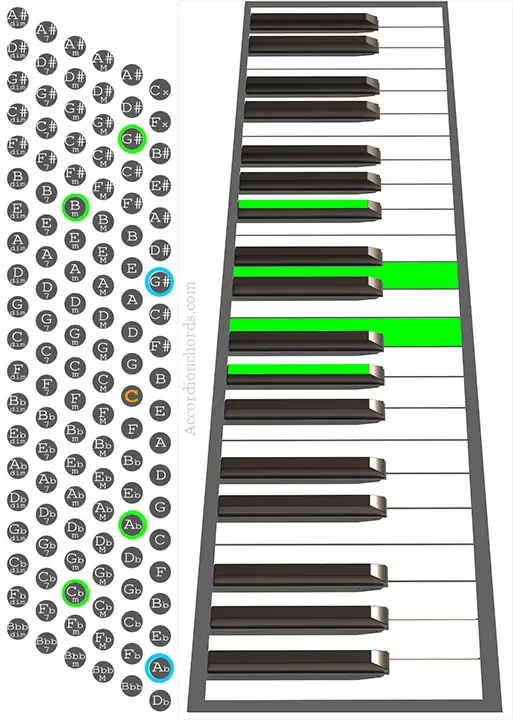AKA: G#∅, G#1/2dim, G#1/2dim7, G# Half-diminished, G#m7(-5), G#m7°5, G#m7b5, G#min7dim5, G# minor seventh flat fifth, G# minor seventh flat five, G#ø, G#º7
G#m7b5 Accordion Chord Chart

m7b5 Chords
To build a half-diminished chord, you should choose a root note and then add the following intervals: a minor 3rd, a diminished 5th, and a minor 7th. Alternatively, you can build the chord by starting with the root and adding a minor 3rd, followed by another minor 3rd, and finally a major 3rd.
For example, a Cm7b5 chord contains the notes C, Eb, Gb, and Bb, which correspond to the root, the minor 3rd, the diminished 5th, and the minor 7th, respectively. If we analyze the intervals between these notes, we can see that there is a minor 3rd between C and Eb, a minor 3rd between Eb and Gb, and a major 3rd between Gb and Bb.
Half-diminished chords are known for their tense and dissonant sound and can be used to create interesting and complex harmonies in a chord progression. In addition to their use in jazz, half-diminished chords can also be found in classical, pop, and other styles of music.
Equivalent chords:
The first inversion of a half-diminished chord (m7b5) is equivalent to the minor 6th chord built on its minor 3rd.
For example, take Am7b5 (A, C, Eb, G). The first inversion is C, Eb, G, A which is a Cm6
In this case:
I° Inversion of G#m7b5 (G#, B, D, F#) = Bm6 (B, D, F#, G#)
(Please note that chord inversions do not work on the Stradella bass system as they do on other instruments or on the accordion keyboard itself. So although these equivalent chords have the exact same notes, they are not interchangeable and should not be intended as inversions of the same chord, at least for what concerns the left hand.)
G#m7b5: In-depth analysis
For a detailed exploration of the G#m7b5 chord, I recommend checking out my article “G#m7b5 Piano Chord – Charts, Harmony, and Music Theory” on ChordsAround.com.
m7b5 Chords on Accordion
To play an m7b5 chord on a Stradella bass system accordion, you will need to select a root note and then combine it with the minor chord built on the minor 3rd degree of its scale.
For example, combining C with an Eb minor (Eb, Gb, Bb) you get a Cm7b5 (C, Eb, Gb, Bb) where C is the root, Eb became the minor 3rd, Gb the diminished 5th and Bb the minor 7th.
The standard bass layout provides two options for playing the root note: on the roots column or on the counter bass column. Both positions are comfortable to play and it is recommended to practice both, as having a second position available may be useful in certain situations.

Notes:
G#, B, D, F#
Intervals:
R, m3°, m5°, m7°
Left hand:
G# + Bm (A♭ + C♭m)
Fingering:
2 + 4 or 3 + 5
or 4 + 2 on counter-bass